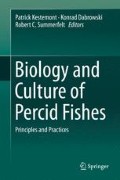Abstract
Percid farming is still in its infancy; however there are already a handful of commercial ventures successfully producing percids. The underlying factors for success for these companies include the introduction of technology that allows a more intensified production that is independent of season, such as RAS systems and the development of out of season spawning. General know how in these companies and research institutions is also accumulating over time. Continued investment in “learning” has resulted in some companies being able to break the barrier of pilot production and move into commercial production. There are still limitations for further upscaling of production. For established companies these include, domestication, stabilizing and streamlining production, slow growth in larger fish and nutrition. New enterprises find it difficult to find financial backing when there is a lack of general information on Percid markets; basing their sales projections on local traditional market prices. Lack of veterinary knowledge of percids and a working knowledge of RAS systems are also limiting in some countries. Finally, there are recommendations for future development necessary for improving production.
Access this chapter
Tax calculation will be finalised at checkout
Purchases are for personal use only
References
Adámek Z, Kouřil J (2000) A long aquaculture tradition in the Czech Republic. Aquac Eur 25:20–23
Adámek Z, Linhart O, Kratochvíl M, Flajšhans M, Randák T, Policar T, Masojídek J, Kozák P (2012) Aquaculture in the Czech Republic 2012: modern European prosperous sector based on thousand-year history of pond culture. Aquac Eur 37:5–17
Barton BA, Barry TP (2011) Reproduction and environmental biology. In: Barton BA (ed) Biology, management and culture of walleye and sauger. American Fisheries Society, Bethesda, MD pp 199–223
Dil H (2008) The European market of the pikeperch for human consumption. In: Percid fish culture from research to production, Namur (Belgium), 23–24 Jan 2008. Abstracts and short communications, Presses Universitaires de Namur, Belgium, pp 15–16
Gjedrem T, Baranski M (2009) Selective breeding in aquaculture: an introduction. Springer, Dordrecht, 221 pp
Kupren K, Czarkowski TK, Turkowski A, Hakuć-Błażowska (2010) European financial instruments for the implementation of fishing and production of water resources. In: Famielec j, Kożuch (eds) The development of environmental policy in the European Union and Poland. Krakow University of Economics, Krakow, pp 297–314, in Polish
Malison JA, Kayes T, Held JA, Amundson CH (1990) Comparative survival, growth, and reproductive development of juvenile walleye and sauger and their hybrids reared under intensive culture conditions. Prog Fish Cult 52:73–82
Müller- Beleke A, Zienert S (2008) Out-of-season spawning of pike perch (Sander lucioperca L.) without the need for hormonal treatments. Aquac Res 39:1279–1285
Policar T, Stejskal V, Bláha M, Alavi SMH, Kouřil J (2009) Technology of intensive culture of Eurasian perch (Perca fluviatilis L.). Practical handbook FFWP USB 89, pp 58 (in Czech)
Policar T, Bláha M, Křišťan J, Stejska V (2011) High quality and stable production of advanced juveniles in pikeperch (Sander leucioperca L.) juveniles. Aquac Int. doi:10.1007/s10499-012-9563-z
Rosauer D, Grzybowski M, Binkowski F, Shepherd B, Goetz F (2008) Developing genetically defined yellow perch (Perca flavescens) broodstocks. In: Percid fish culture from research to production, Namur (Belgium), 23–24 Jan 2008. Abstracts and short communications, Presses Universitaires de Namur, Belgium, pp 128–129
Rougeot C, Mélard C (2008) Genetic improvement of growth in perch production: domestication, sex control, hybridization and strain selection. In: Percid fish culture from research to production, Namur (Belgium), 23–24 Jan 2008. Abstracts and short communications, Presses Universitaires de Namur, France, pp 35–39
Steenfeldt S, Vestergaard M, Overton J, Lund I, Paulsen H, Larsen V, Henriksen N (2010) Videreudvikling af intensivt opdræt af sandart i Danmark. DTU-Aqua rapport nr. 228-2010. Institut for Akvatiske Ressourcer, Danmarks Tekniske Universitet, Hirtsals, 96p. In Danish
Teletchea F, Fontaine P (2012) Levels of domestication in fish: implications for the sustainable future of aquaculture. Fish Fish. doi:10.1111/faf.12006
Turkowski K, Lirski A (2010) Utility and market value of earthen fish ponds in Poland. In: Cieśla, Lirski (eds) Multifunctionality in pond aquaculture in Poland. Current status. Warsaw University of Life Sciences. Editorial House Wieś Jutra, Warsaw, pp 26–39
Turkowski K, Hakuć-Błażowska A, Kupren K, Czarkowski K (2010) European financial instruments to support environmental functions of fisheries management in Natura 2000. In: Famielec J, Kożuch (eds) The development of environmental policy in the European Union and Poland. Krakow University of Economics, Krakow, pp 297–314, in Polish
Watson L (2008) The European market for perch (Perca fluviatilis). In: Percid fish culture from research to production, Namur (Belgium), 23–24 Jan 2008. Abstracts and short communications, Presses Universitaires de Namur, Belgium, pp 10–14
Acknowledgements
This chapter was prepared in part thanks to the following projects: CENAKVA (CZ.1.05/2.1.00/01.0024), CENAKVA II (LO1205), NAZV (QI 101C033).
Author information
Authors and Affiliations
Corresponding author
Editor information
Editors and Affiliations
Rights and permissions
Copyright information
© 2015 Springer Science+Business Media Dordrecht
About this chapter
Cite this chapter
Overton, J.L., Toner, D., Policar, T., Kucharczyk, D. (2015). Commercial Production: Factors for Success and Limitations in European Percid Fish Culture. In: Kestemont, P., Dabrowski, K., Summerfelt, R. (eds) Biology and Culture of Percid Fishes. Springer, Dordrecht. https://doi.org/10.1007/978-94-017-7227-3_35
Download citation
DOI: https://doi.org/10.1007/978-94-017-7227-3_35
Publisher Name: Springer, Dordrecht
Print ISBN: 978-94-017-7226-6
Online ISBN: 978-94-017-7227-3
eBook Packages: Earth and Environmental ScienceEarth and Environmental Science (R0)

